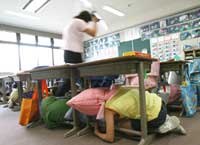|
In Japan there is now a working early-warning system that can detect an earthquake immediately after it takes place and inform people that the ground is about to start shaking. This system detects P-waves in the immediate aftermath of a temblor and informs people that the destructive S-waves are coming. This groundbreaking Japanese system has been widely publicized on TV and in other media since October, and many Japanese have high hopes for the system.

Elementary school children practice taking cover after receiving a warning of an impending earthquake.
Difference in Wave Speed the Key
Japan is extremely prone to earthquakes, and these seismic events have caused a great deal of damage on numerous occasions in the past. The development of this revolutionary system is the result of many years of research by seismologists and others. The system uses data collected by the National Meteorological Agency and others via seismic instruments at around 1,000 locations across the country. When an earthquake strikes, the seismic instruments nearby measure and instantly analyze the P-waves. (P-waves are primary waves and travel at a speed of 7 kilometers per second.) The system then notifies the areas that are about to be hit by the slower but stronger S-waves. (S-waves are the destructive secondary waves and travel at a speed of 4 km per second.)
The early-warning system provides two types of notifications - one for high-end users, such as railway operators and automated factories, and another for ordinary people that gets the message out via TV, radio, or announcements in public facilities. Those for high-end users provide such detailed information as the time of the quake, the epicenter, the estimated strength of the quake, the name of the region in the event that the quake is estimated at 4 or higher on the Japanese scale, and the estimated strength of the seismic activity in areas where the quake is estimated at 5 or higher, as well as the estimated arrival time of the S-waves. Priority is given to a speedy response - the first report goes out two to three seconds after the earthquake, and subsequent reports increase in accuracy. In order to receive such reports, it is necessary to conclude a contract with the provider. The notifications for ordinary households, by contrast, do not provide such specific information. When an earthquake of intensity "weak 5" or greater on the Japanese scale is detected by two or more seismic stations, it informs users of the time of the quake, the epicenter, and the locations expected to be affected by tremors of 4 or greater on the Japanese scale.
System Helped Children Take Cover
A trial of the system began in August 2006, providing nearly the same information currently given to high-end users. Some 746 companies, government agencies, and households received the service to begin with, and this number has grown dramatically since the official launch.

The earthquake early-warning system.
The system produced results even in the test stage. In the 6-strong Niigata Chuetsu-oki Earthquake that struck in July 2007, an emergency report was received 52 seconds ahead of tremors at the National Disaster Medical Center in Tachikawa City, Tokyo Prefecture. The elevators in service were made to stop at the nearest floor, and an announcement was made throughout the facility. Railway operators in the Kanto region were given between 30 and 60 seconds advance notice, enough time to stop their trains. In Nagano Prefecture's Ueda City, the early warning was received 17 seconds ahead of the tremors and was transmitted to households via wired broadcast. Children took shelter under their desks and moved away from furniture likely to fall over. By enabling people and organizations to take these kinds of actions, the system can reduce damage from an earthquake before it strikes.
This early-warning system has its limits, however. Advance warning of tremors is short, ranging from slightly over 10 seconds to just under one minute. And if an earthquake strikes nearby, there might not be enough time for a warning at all. It can also sometimes mistake lightning for a temblor. In order to make effective use of this revolutionary system, it is important to understand its features and limitations and practice taking the appropriate action when an early warning is received.
|